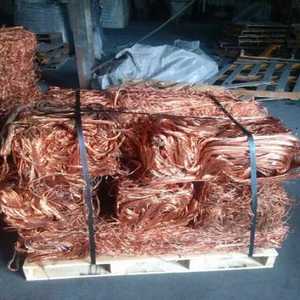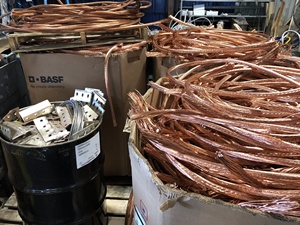
All categories
Featured selections
Trade Assurance
Buyer Central
Help Center
Get the app
Become a supplier

(11649 products available)








































Iron powders are available in diverse forms, each with unique attributes and advantages for various sectors. The process of copper coating involves applying a thin layer of copper onto the surface of iron powder particles. This technique intends to enhance the subsequent powder's conductivity, corrosion resistance, and mechanical properties. Here is a rundown of the common types.
Chemically coated iron powder involves a copper layer deposited through chemical means, such as electroplating or chemical deposition. This technique allows for precise control over the thickness of the copper coating so that it can be adjusted to suit particular needs. The chemical process guarantees a uniform application of copper on iron powder particles, even on complex shapes. The thin, tightly bonded copper layer provides good conductivity and chemical resistance.
This variety is produced by immersing iron powder in an electrolyte solution and applying an electric current that deposits copper onto the powder's surface. This technique is known for its ability to produce a thick and uniform copper coating. It's widely used in situations where high conductivity is requisite. The electro-coated variety is highly regarded in the metals and electrical sectors.
In the mechanical process, iron powder is mixed with copper powder and then compressed or treated in a manner that bonds the two materials under force. This method establishes a mixed powder with copper coating particles adhering to the surface of the iron powder grains. The mechanical coating is cost-effective and simple, and it works well for applications where moderate copper content suffices. This process is not as robust as chemical methods in terms of coating adherence and consistency.
Thermal spraying involves melting or partially heating copper and projecting it onto iron powder particles. The method establishes a robust bond between copper and iron by embedding copper into the surface of each iron grain. Thermal spraying is effective for applications under severe wear and tear or high-stress environments. The copper layer is thicker and more resilient than in other processes; thus, it is appropriate for demanding industrial uses.
Electrical Components Manufacturing
In the electrical components manufacturing industry, copper-coated iron powder is in motors and inductors' stators, rotors, and coils. The copper coating raises electrical conductivity, augmenting energy transfer and reducing power loss. This applicability makes copper-coated iron powder essential in the materials sphere for producing efficient and reliable electrical systems.
Batteries and Energy Storage Systems
The copper coating boosts electrical conductivity and interparticle connection in lithium-ion batteries. It is notably used in battery anodes where iron powder coated with copper improves the performance, stability, and functional life of batteries. The enhanced battery efficiency directly benefits consumer electronics, electric vehicles, and renewable energy storage systems.
Thermal Management Solutions
In thermal management applications, heat sinks, and exchangers use copper-coated iron powders. The copper coating grants exceptional heat dissipation while maintaining the structural integrity of the sink or exchanger. This makes it important for numerous industries, including electronics, automotive, and HVAC systems that require reliable cooling mechanisms.
Powder Metallurgy
Powder metallurgy industries use sintered components of performing mechanical parts and tools, including gears, bearings, and fasteners. Copper-coated iron powder improves sintering bonds, producing strong and durable materials with superior mechanical properties. The resulting components find extensive uses in industries like machinery, automotive, and aerospace, where reliability is key to superior performance.
Additive Manufacturing
In the additive manufacturing sector, copper-coated iron powder is for 3D printing of metal parts. For instance, the copper coating aids in effective electrical applications while reducing oxidation during the printing process. This property makes it a valuable material in prototyping and production across different industries. These include aerospace, automotive, and engineering, where lightweight yet conductive components are made.
Selecting the right iron powder coated with copper requires a careful assessment of some key factors for an optimal outcome in any project. Below are these factors.
Copper coating adherence and thickness
When choosing iron powder, one of the most critical factors is the adherence and thickness of the copper coating. This is because a well-adhered coat guarantees that the copper will not peel or flake under stress. Furthermore, the thickness should be appropriate for the desired application. A thicker coat ups durability and conductivity, while a thinner one is sufficient for lighter use.
Particle size and distribution
The desired applications highly determine the needed particle size and distribution of the copper-coated iron powder. Narrow size distribution ensures compact and uniform densities during powder metallurgy applications. Alternatively, a mixture of particle sizes could provide a better surface area for electroplating in battery applications. Always ensure the particle size selected fulfills the project requirements.
Purity and contamination level
Always check the product's purity level; it significantly affects the performance of coated powders. High-purity iron powder has fewer impurities and contaminants, which impact the powder's magnetic and mechanical properties. This is particularly important in electrical and electronic applications. Ensure the chosen product has low sulphur, carbon, and other metallic contaminant content.
Customization and quality consistency
Depending on the applications, there might be a need for customization in copper-coated iron powders, such as bespoke coating thickness or tailored particle sizes. Work only with reputable manufacturers who provide consistent quality. Variability in powder characteristics can lead to failure in performance or inconsistency in product quality, particularly in those applications that require high levels of uniformity.
Compatibility with other materials
The coated powder interacts with other materials in the project, such as resins, binders, and sintering elements, in several end applications, like battery components and powder metallurgy. In such scenarios, assess the potential chemical compatibility of the copper coating with these other materials. Potential reactions may cause contamination or degrade performance. Therefore, there is a need for thorough research on the product.
A1: Application of copper coating on iron powder improves several features, like enhanced conductivity, corrosion resistance, and superior wear characteristics. Heavily, these improvements make the copper-coated iron powder indispensable in metals and engineering applications, such as battery production, thermal management, and electric motor components.
A2: One such environmentally friendly process of copper coating is chemical deposition techniques. This method includes electroplating, where copper ions are deposited onto iron particles in a controlled manner. This technique can be performed in a way that minimizes copper waste and recycles the solution, thus reducing environmental impact.
A3: Lithium-ion batteries use copper-coated iron powders for anodes, benefiting from high purity, uniform particle size, and good electrical conductivity. Besides, the copper coating provides increased surface area for lithium interaction, improving battery capacity, stability, and longevity – all essential factors for performance in energy storage systems.
A4: While mechanically coated iron powder is cost-effective and suitable for projects with low to moderate copper need, the electro-coated variety provides superior copper-thick and more robust adherence. As such, the former is appropriate for general applications where copper content is moderate. On the other hand, the latter is more suited to demanding electrical and thermal applications.
A5: Several factors affect the durability of copper coating on iron powder. These include the techniques used for application, the environment to which it is exposed, and the coating thickness and particle size. For instance, corrosive environments significantly impact thinner coats, while thicker coats offer better durability.